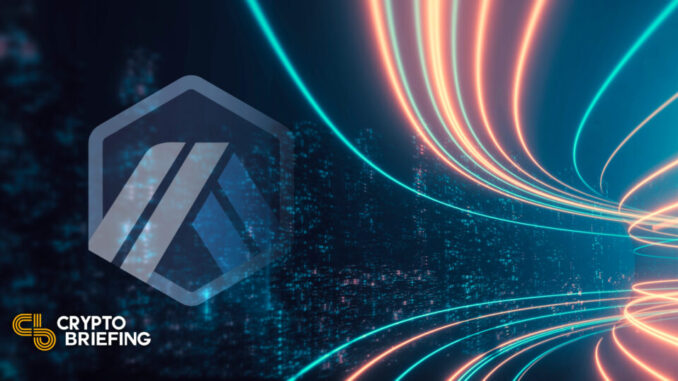
Essential Insights
Arbitrum has finalized its Nitro enhancement.
Arbitrum indicates that Nitro amplifies transaction capacity, diminishes costs, and enhances the user experience for developers creating applications.
With Nitro boosting Arbitrum’s transaction capacity, the network is poised to relaunch its Arbitrum Odyssey Campaign.
Share this article
The Arbitrum Nitro enhancement facilitates quicker transactions, reduced costs, and an improved user experience for developers constructing applications.
Arbitrum Transition to Nitro
Arbitrum Nitro is operational.
The Ethereum Layer 2 network successfully transitioned the existing Arbitrum One system to Arbitrum Nitro on Wednesday, precisely one year since the network’s mainnet was initially launched. Offchain Labs, the organization behind Arbitrum, announced the successful update on Twitter.
Arbitrum Nitro eliminates previous restrictions imposed on the network and introduces multiple significant enhancements. Previously, Arbitrum’s transaction capacity was limited to uphold network efficiency and reliability. However, with the upgrade to Nitro, these restrictions have been removed, greatly enhancing the volume of transactions that the network can process.
The Nitro enhancement has also contributed to compressing the transaction data sent back to Ethereum mainnet for validation. Nitro is expected to decrease the number of zero bytes in Arbitrum transaction batches, resulting in even lower transaction costs for end-users. While Arbitrum already offers fees that are 90 to 95% lower than those on Ethereum mainnet, estimates suggest that by eliminating zero bytes, the Nitro upgrade could further reduce fees by 27%.
However, the primary benefit of the Nitro upgrade lies in a new prover, capable of processing Arbitrum’s interactive fraud proofs utilizing WebAssembly code. This advancement allows the Arbitrum engine to be written and compiled using standard languages and tools, replacing the previously used custom language and compiler. Consequently, this leads to a substantially more streamlined and user-friendly experience for developers on Arbitrum, which the team anticipates will encourage greater activity on the network.
Offchain Labs CEO and co-founder Steven Goldfeder stated to Crypto Briefing that the update would “significantly enhance network capacity and notably lower costs,” which should consequently draw more projects to the ecosystem. He remarked that Arbitrum is “the most Ethereum-compatible rollup ever developed,” elucidating that the internal structure of Nitro aligns with Ethereum’s, therefore the network can accommodate development and user tools designed for Ethereum.
In addition to the primary updates to Arbitrum mainnet, Nitro has also activated the network’s AnyTrust technology, delivering a secure and cost-effective scaling solution tailored for gaming and social applications. This same technology is behind the recently unveiled Abritrum Nova chain that features a “Data Availability Committee” with participation from Google Cloud, FTX, Reddit, Consensys, P2P, and QuickNode.
Now that Nitro has enhanced Arbitrum’s transaction capacity, the network will likely resume its Arbitrum Odyssey Campaign. Odyssey was paused shortly after its launch in June due to a surge in transaction volumes leading to gas fees on the Layer 2 exceeding those on Ethereum mainnet. The campaign aims to onboard users into the Arbitrum ecosystem, rewarding participants who accomplish on-chain tasks with NFTs.
Arbitrum is among several Layer 2 networks providing scaling solutions for Ethereum. Since its launch last year, Arbitrum One has emerged as Ethereum’s predominant Layer 2 network, holding roughly $2.5 billion in total value locked, according to L2Beat. Goldfeder pointed out that its growth has been “entirely organic” as the project has not provided ecosystem incentives such as tokens (in contrast to its primary competitor, Optimism, which does have a token).
The initiative employs Optimistic Rollups to batch transactions and relay them back to Ethereum mainnet for validation, thereby increasing throughput and reducing costs. Ethereum mainnet. Several established Ethereum DeFi protocols, including Uniswap, Curve, and Aave, have deployed their contracts on the network. Arbitrum also hosts numerous native protocols, such as GMX, Dopex, and Vest Finance.
Disclosure: At the time of writing this article, the author possessed ETH and various other cryptocurrencies.
Share this article








Be the first to comment